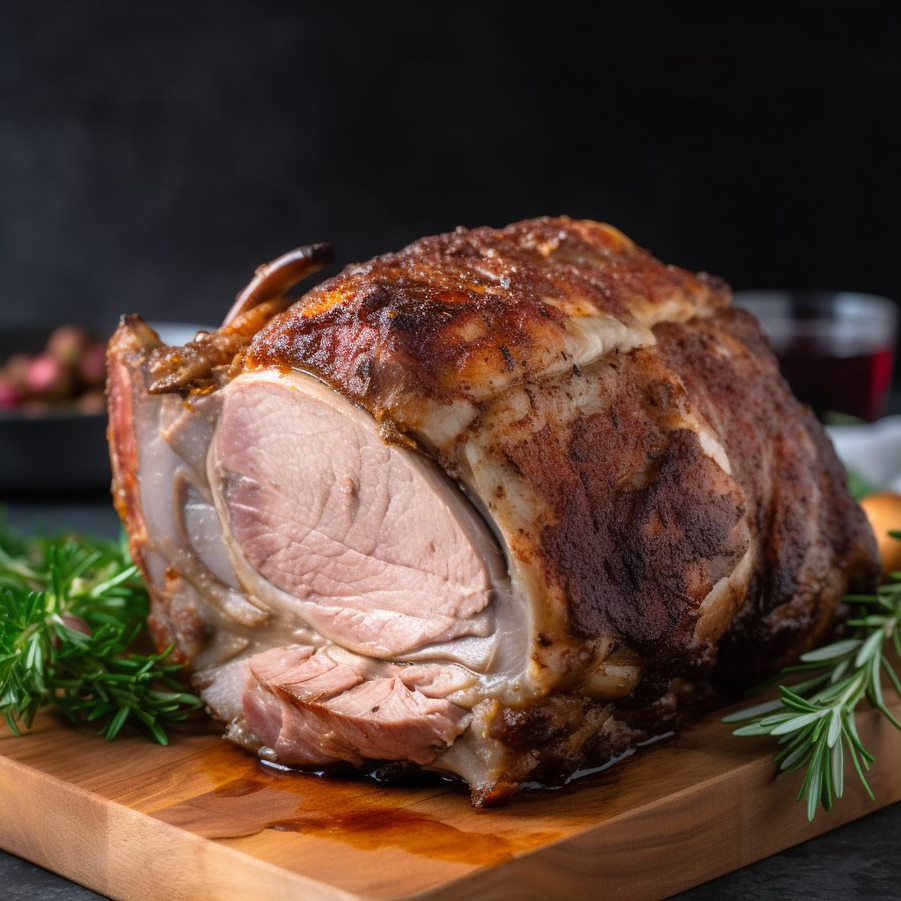
Servings: 8
Preparation Time: 15 minutes
Start to Finish Time: 29 hour 5 minutes
Jump To Recipe.
If you’re looking to elevate your next holiday feast or family dinner, the Slow-Roasted Bone-In Pork Rib Roast is an absolute showstopper. This dish is a beautiful centerpiece that combines the rich, savory flavors of slow-cooked pork with an elegant, decadent Port Wine Cherry Sauce that brings a touch of luxury to the table. The roast, prepared with care and patience, transforms into a tender and juicy masterpiece that’s sure to impress even the most discerning palates.
What makes this dish truly exceptional is the preparation method. The pork rib roast is seasoned with a sugar and salt rub and cured overnight. This not only enhances the flavor but also gives the roast a stunning mahogany hue when cooked. Slow roasting locks in moisture, ensuring that every slice is succulent and full of flavor, while cooking the roast with the bone attached adds an extra layer of depth to the meat. It’s an ideal choice for a festive gathering or an indulgent weekend meal when you want to take your time and savor the process.
The star of the show: Port Wine Cherry Sauce
The crown jewel of this dish is the Port Wine Cherry Sauce—a rich, luxurious complement to the savory pork. The sauce combines the deep, fruity notes of dried cherries with the complexity of port wine and balsamic vinegar, creating a perfect balance of sweetness and acidity. Fresh thyme and shallots add a layer of aromatic complexity, while the velvety finish of butter and heavy cream brings the sauce together, making each bite feel indulgent. The sauce is rich without being overpowering, providing a perfect contrast to the savory flavors of the roast.
Tips for perfection
The key to mastering this recipe is the balance of time and temperature. Curing the pork rib roast overnight ensures the meat is well-seasoned and stays juicy throughout the slow-cooking process. To achieve perfectly cooked pork, monitoring the temperature is crucial. An oven probe thermometer is recommended to help you avoid overcooking, and it’s important to check the temperature as infrequently as possible to maintain the heat within the oven.
For easier carving, ask your butcher to remove the chine bone, allowing you to slice clean, beautiful portions of the roast with ease. This attention to detail makes serving a breeze, and when you present this dish, you’ll be sure to impress everyone at the table.
A dish made for special occasions
This Slow-Roasted Bone-In Pork Rib Roast is a perfect centerpiece for any holiday gathering or special event. The combination of melt-in-your-mouth pork and the sophisticated, flavorful cherry sauce will leave your guests talking about it long after the meal is over. With its tender meat, rich sauce, and impressive presentation, it’s a recipe that’s made to be shared with loved ones during those moments you want to remember.
Ingredients:
Pork Roast
5 pounds pork rib roast, center-cut bone-in, chine bone removed (see TIPS)
2 tablespoons dark brown sugar, packed
1 tablespoon kosher salt
1 1/2 teaspoon black pepper
Port Wine Cherry Sauce
2 cups wine, port
1 cup dried cherries
1/2 cup balsamic vinegar
4 sprigs fresh thyme, plus 2 teaspoons minced
2 each shallots, minced
1/4 cup heavy cream
16 tablespoons unsalted butter, cut into 1/2-inch pieces and chilled
1 teaspoon salt
1/2 teaspoon pepper
Instructions:
DAY 1: PORK ROAST (refrigerate overnight, see NOTES):
Using sharp knife, remove roast from bones, running knife down length of bones and following contours as closely as possible. Reserve bones.
Combine sugar and salt in small bowl.
Pat roast dry with paper towels. If necessary, trim thick spots of surface fat layer to about 1/4-inch thickness. Using sharp knife, cut slits, spaced 1 inch apart and in crosshatch pattern, in surface fat layer, being careful not to cut into meat. Rub roast evenly with sugar mixture.
Wrap roast and ribs in plastic wrap and refrigerate for at least 6 hours or up to 24 hours.
DAY 2: ROAST THE PORK (4 hours + 10 minutes):
Adjust oven rack to lower-middle position and heat oven to 250°.
Sprinkle roast evenly with pepper.
Place roast back on ribs so bones fit where they were cut; tie roast to bones with lengths of kitchen twine between ribs.
Transfer roast, fat side up, to wire rack set in rimmed baking sheet. Roast until meat registers 145°, 3 to 4 hours (see TIPS).
LET REST & BROIL, THE CARVE (40 minutes):
Remove roast from oven (leave roast on sheet), tent loosely with aluminum foil, and let rest for 30 minutes.
Adjust oven rack 8 inches from broiler element and heat broiler.
Return roast to oven and broil until top of roast is well browned and crispy, 2 to 6 minutes.
Transfer roast to carving board; cut twine and remove meat from ribs.
Slice meat into 3/4-inch-thick slices and serve, passing sauce (SEE BELOW) separately.
PORT WINE CHERRY SAUCE (while roast cooks…takes 45 minutes):
Combine port and cherries in bowl and microwave until steaming, 1 to 2 minutes.
Cover and let stand until plump, about 10 minutes.
Strain port through fine-mesh strainer into medium saucepan, reserving cherries.
Add vinegar, thyme sprigs, and shallots to port and bring to boil over high heat.
Reduce heat to medium-high and reduce mixture until it measures 3/4 cup, 14 to 16 minutes.
Add cream and reduce again to 3/4 cup, about 5 minutes.
Discard thyme sprigs.
Off heat, whisk in butter, few pieces at a time, until fully incorporated.
Stir in cherries, minced thyme, salt, and pepper. Cover pan and hold, off heat, until serving.
Alternatively, let sauce cool completely and refrigerate for up to 2 days. Reheat in small saucepan over medium-low heat, stirring frequently, until warm.
To dress it up for a holiday feast, we pair it with a rich, elegant sauce. The roast is perfectly cooked and juicy (from the rub, overnight curing and slow cooking). The cherry sauce is VERY rich and yet compliments the pork perfectly. Cooking the roast attached to the bone by twine kept the roast from drying out and added flavor.
TIP: For easier carving, ask the butcher to remove the chine bone.
TIP: Monitoring the roast with an oven probe thermometer is best. If you use an instant-read thermometer, open the oven door as infrequently as possible and remove the roast from the oven while taking its temperature.
NOTE: This recipe requires refrigerating the salted meat for at least 6 hours before cooking.
NOTE: Why Add Cream to a Butter Sauce? To dress up our pork, we turned to a classic French preparation: beurre rouge. The beauty of this sauce, which translates as “red butter,” is that at its most basic it requires just two components: butter and an acidic liquid. (Red wine and red vinegar for beurre rouge and white for beurre blanc are traditional.) The preparation is equally simple: Just whisk cold butter into the reduced acidic liquid.
MAKE AHEAD: The sauce may be prepared in advance or while the roast rests.
